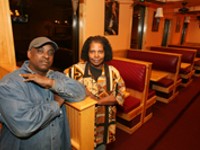[
{
"name": "500x250 Ad",
"insertPoint": "5",
"component": "15667920",
"parentWrapperClass": "",
"requiredCountToDisplay": "1"
}
]
I love root beer, the Great American Soda. It varies as much as wine and beer, and there isn't really a dominant brand. Popsoda.com sells nearly 40 brands, and there are well over a hundred you can hunt down. Beers of the World had eight recently, and Tops and Wegmans have decent selections. We even have a few regional brands, including Pirate's Keg, Iron Fireman, and the mysteriously named Napa Valley Soda Co.
So I assembled a panel of experts, tracked down 36 brands, and had a tasting. We got 24 in a root beer gift pack from popsoda.com ($29.99 plus a whopping $35 for shipping), and drove around town to find the others (Abundance Market and Lori's Natural Foods were prominent sources). City contributor Michael Warren Thomas hosted us, broadcasting the first hour live on his program, For the Love of Food.
Root beer has no standard definition, but it does have history. The early American colonists drank beer on their ocean voyages because it was safer than stored water (uh-huh). They wanted to make more, um, safe beverages in the New World, but without the correct grains, they turned to anything they could find: roots, barks, and herbs. Those colonial brews were fermented, making them --- say it with me --- "safe."
Fast-forward to the mid-19th century, and we find Charles Hires hawking a root-tea health tonic. In 1876, he introduced commercial root beer at the Philadelphia Centennial Exhibition, and by 1893 his family was selling a bottled version.
Root beer has been flavored by all sorts of things: allspice, coriander, ginger, even hops. Sassafras root became the standard until the FDA proclaimed it carcinogenic in 1960. Since then, brewers have scrambled, creating new flavor blends, and even removing the offending oil, safrole, from sassafras root (although sassafras-flavored root beers are rare today).
The Root Beer Team included Burgerologist Stan Merrill, Michael Warren Thomas, self-proclaimed expert Bruce Vernon Johnson, and the author (loyal reader Kathryn Hill was a huge help with background information). We sipped a bit of each soda, then rated it in six areas: sweetness, spice, aftertaste, carbonation, smoothness, and gestalt. In all categories save sweetness, a higher score meant we liked it better, whereas sweetness measured potency.
For example, we began with A&W: very sweet (7.7); little spice (4.3); chemically aftertaste (3.3); decent carbonation with a good head (6.6); fairly smooth (6.6); but little gestalt (4.3). Its average score (not including sweetness) of 5 put it squarely in the middle of the pack.
Most fell into two categories: everyday drinks and boutique brews. A&W is an everyday drink, as are IBC, Dr. Brown's, Hank's, and Jones (crappy carbonated corn syrup with strong marketing). Then there are the complex drinks: Virgil's (expensive with strong anise flavor), AJ Stephan's (clove/floral bouquet), and the marvelous Root 66. This isn't a better/worse distinction. Some, like Stewart's, straddle the line, and we loved and hated some of each type.
Still, five of our least favorite were of the boutique variety. Stan called Mystic Seaport "weird," and Bruce complained of its being unbalanced. I called Gale's, with its cinnamon-ginger-vanilla flavor, "wrong-headed," and Stan said, "I'm sure somebody, somewhere likes this, but not me." Stan pronounced Natural Brew a "poor substitute for root beer," and asked, "Was this made in Russia?" Two certified organic drinks were atrocious: Blue Sky tasted like acidic licorice, and Santa Cruz received our only zero for gestalt (if I want cough syrup, I'll buy cough syrup).
Aficionados love Henry Weinhard's, made by an Oregon brewery now owned by Miller (available from popsoda.com). Weinhard's has a terrific head, and a creaminess that would be great for floats. But it wasn't "rooty," and didn't crack our top five.
Number five was the intense Root 66 (Skippy's serves it). It exemplifies a cane-sugar-sweetened soda, with a flavor like caramel or even cotton candy. With its pronounced birch and sarsaparilla flavors, Bruce found it "challenging and bold," but felt it lacked balance. Still, we all agreed it would make a great occasional drink.
A nearly local product came in fourth. Ithaca Soda Company's root beer, also cane-sweetened, impressed with smooth complexity. It had a pleasant, lingering aftertaste, and high-quality sweetness. I don't think you can buy it here yet, but Ithaca isn't far. Stan's daughter, Julia, didn't like it, but perhaps boutique root beers aren't for kids (though my kids dig Root 66).
If you're looking for something that is likely to please kids, some of our middle-tier drinks might be just the ticket. Hank's is a bit sweet, but smooth and well-balanced, which could also be said of Sioux City. But would either be worth the shipping when Saranac and IBC are in local stores?
IBC deserves its contemporary classic status. It's smooth, light, and highly drinkable, with decent carbonation and no aftertaste. Plus, it's got the grooviest bottle going and is flat-out cheap ($2.50/six on special). Saranac costs a bit much ($4/six), and the panel was split on it. I didn't care for its citric qualities, but Stan called it "a classic, well-balanced root beer." It did get one of our highest carbonation scores, though, and is an upstate product (Utica).
Cool bottles are a plus, and most root-beer makers seem to put some effort into them. IBC bottles have raised glass art with no label. One of the people who stopped by during the tasting was University of Rochester Art Historian Rachel Haidu, who commented on several bottles (she disliked the "upsetting, new-age label" on Abita). We all liked the bottles with art printed onto the glass (Stewart's and Frostie).
Back to the countdown, our third favorite was Shenendoah from Vermont (available at Abundance). It has real sassafras, and is very complex, with a medium, honey-like sweetness and moderate carbonation. Stan called it "the Guinness of root beers," and Bruce was impressed by its benign aftertaste. If you want to try a fancy root beer, start here.
The runner-up was Thomas Kemper (Seattle), the only one I'll be willing to pay to have shipped ($36/case shipped from beveragesdirect.com). Kemper is flavored with vanilla and real sassafras, with a grainy, almost beer-like flavor. It has a superior head, and mild, complex sweetness combining sugar, corn syrup, and honey. It's a delicious drink you could have every day.
Stewart's, our favorite root beer, came up in the middle of the tasting, and was nearly perfect. It has an 80-year history, mostly as a fountain drink available only at Stewart's stands. It's been available in bottles since 1990. It's not too sweet; has spice that says "root beer" without being overbearing; has exceptional creaminess, both in the carbonation and in "mouth feel," as Bruce put it; and the bottle is cool. Priced between IBC and Saranac, it's available all over. It's great for drinking and for floats. It is, in short, everything you could ever want in a root beer.
So next time you're having a cookout, ditch the cola and go with root beer. You can get a very good one on the cheap (IBC), or spend a little more and have the very best (Stewart's). We don't recommend trying 36 brands over a four-hour period, though. Leave that to the experts.
Latest in Gut instincts
More by Adam Wilcox
-

Miché Fambro and the meaning of success
Feb 1, 2021 -

Ariana Kabob House
Jan 3, 2007 -
"Truly Hairy Fairy Tales"
Dec 27, 2006 - More »





